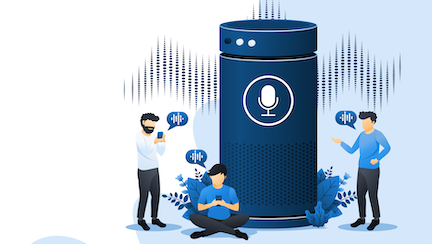
Voice experiences will be the future or the end of your business.
How big will voice-driven experiences like voice search and voice assistants become for your business?
Remember how smartphones took off after the introduction of the iPhone?
In just a few years, everybody had one. Especially as smartphones hit the tipping point of having abilities that appealed to both personal and business use.
As consumers and businesses rushed towards adoption, a whole new e-commerce ecosystem evolved. This was because the smartphone increasingly became the prime intermediary between an individual and their ability to access services and product information. From the company email to concert tickets.
It was also the way to communicate with someone wherever they were located. No longer did you have to wait for them to get back to their desktop or for you to find a place to crack open your laptop.
With such rapid change, the desktop, once the traditional access point, lost its dominance for both groups. Mobile became dominant. Soon after, unchallenged.
That’s happening with voice. Just a whole lot faster.
Devices that use voice interfaces, like the iPhone’s Siri and Amazon’s Alexa devices are growing at a faster rate than the smartphone. According to Pew Research, 46% of people already use them to aid them in making purchases.
And while most of us have just one smartphone. 40% of us likely have access to multiple voice assistants and devices. For me, there’s Google Assistant on my phone. Google Home, Alexa devices or Siri on HomePod in my house and in my car.
Pew Research confirms my own experience. They report that while the under half surveyed use voice interfaces with their smartphone, more than 50 percent of other users report voice use spread between their computer, tablets and other devices.
All those options mean that, in 2020, over 94.2 million smart speakers among a total of over 125 million devices will have access to consumers. A rise of 75% from 7% in 2016.
Juniper Research is even more bullish on voice. The firm estimates there will be 8 billion digital voice assistants in use by 2023.
Let’s not forget business adoption for voice assistants.
More and more sectors of the economy, like healthcare and the automotive industry, are finding uses for the speech recognition technology.
Industries like healthcare are building voice assistants designed to allow patients to ask questions around a diagnosis in the doctor’s office or call for medical assistance.
Businesses including one I’ve worked for are building assistants for the enterprise. A way for employees to get quick company information and actionable project data through voice requests. As support for employees, these voice assistants can streamline or replace internal management apps and HR services.
Tractica, a market intelligence firm, reports that the voice assistant growth in the business world is expected to increase from 155 million users in 2015 to 843 million by 2021. With that kind of projected growth, revenue is forecasted to grow from $1.6 billion in 2015 to $15.8 billion in 2021.
All those smart speakers and voice assistants for business and consumers are estimated to become a 40-billion dollar market.
So why should your business adopt voice?
Why do you rob a bank? Because that’s where the money is.
As a business, sooner than later, you will need voice to capture if not simply maintain market share. Not to mention that voice is quickly becoming a touch point that consumers are pivoting to.
I’m not talking just voice search. While voice search on platforms like Google is important. It’s also any device that serves as the conversational layer between the user, a business or product information.
Voice assistants are your business.
TVs, cars, refrigerators, wearables, doors, medical devices and more will eventually become enabled with voice interfaces. Those products and the voice services that align with them can establish relationships with future customers. Often within your customer’s own home or on the go; far away from any retail locations you or your competitor may own.
Also, we are coming to an age where customers don’t walk into retail locations until they need to. A trend likely hastened further due to the pandemic.
An example. I have money in the bank and do transactions, but I rarely walk into a bank. I’m not alone. So “Jane” the bank teller in the bank isn’t building a relationship with me. I don’t’ see Jane’s smile. Jane and I can’t meet to joke and laugh together about the weather. The bank isn’t a personal Jane experience for me. Instead, the ATM and the banking app on my phone is my point of contact.
Now imagine if I could talk with the app or services on my phone to make a deposit. Check my balance. Ask about new services. And my engagement is happening through a helpful friendly voice that creates an amazing and brandable customer experience. One that the customer would usually avoid by not going into the bank.
With voice and the AI behind it:
- Your business becomes more efficient and beneficial to your customers
- You create an incredible brand experience
- Your customer experience can be anywhere the customer is
- Voice is frictionless. Don’t know what buttons to push? Doesn’t matter. just ask
- Personalization. Once I have an experience with your voice assistant, it’s learning about the customer and interaction. Next time, it can deliver an even better experience. It may know your name and remember your preferences from the interaction before. That’s opposed to meeting a brand new human on your next interaction and starting your new transaction from scratch
You can do all that with voice. Or not. The choice. And your businesses’ future, is up to you.
Why voice assistants will be a vital part of how you do business or even if you stay in business in less than five years.






























